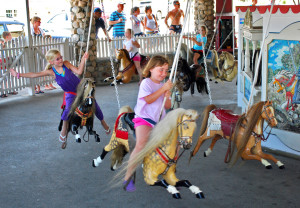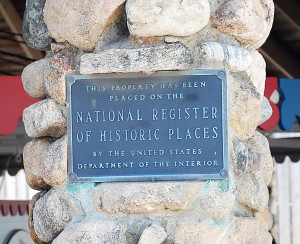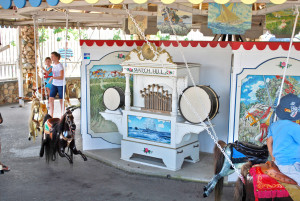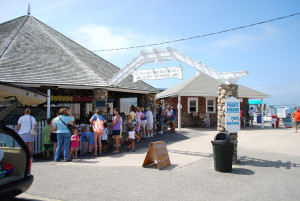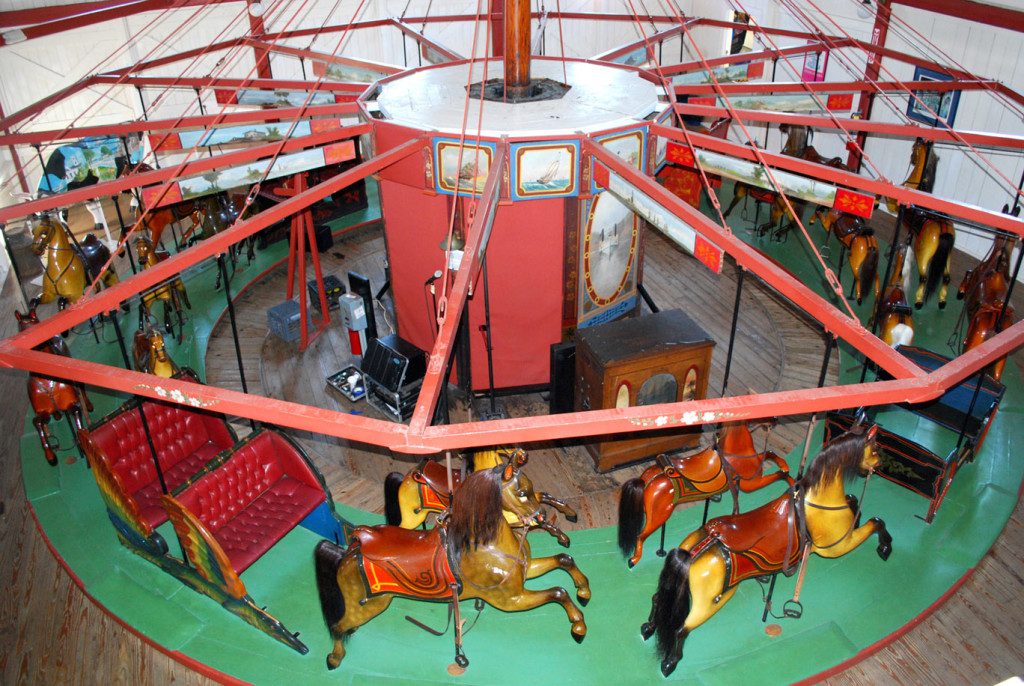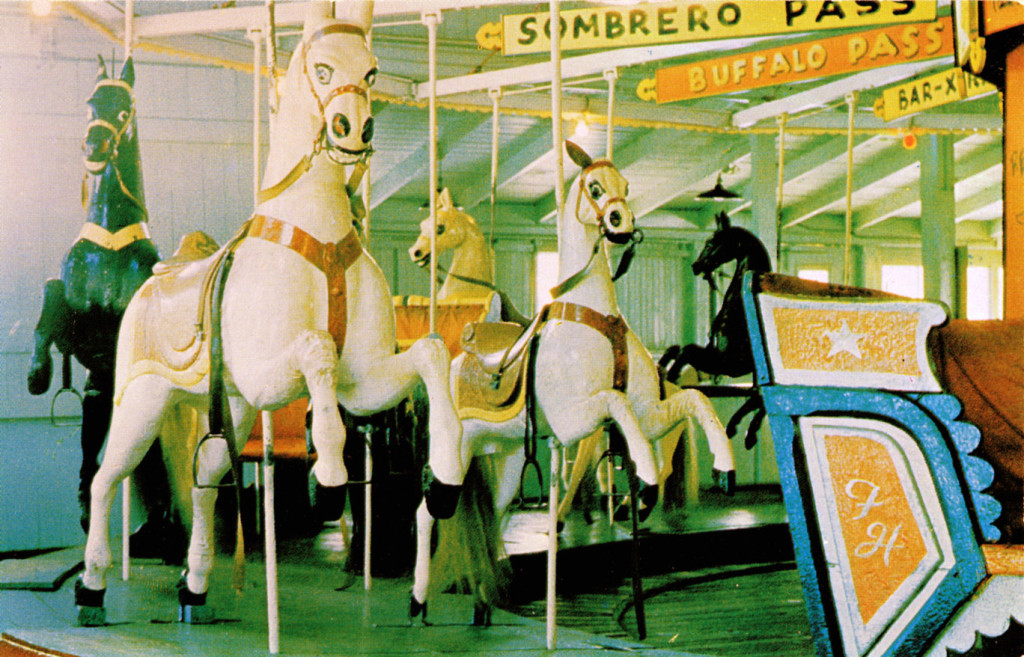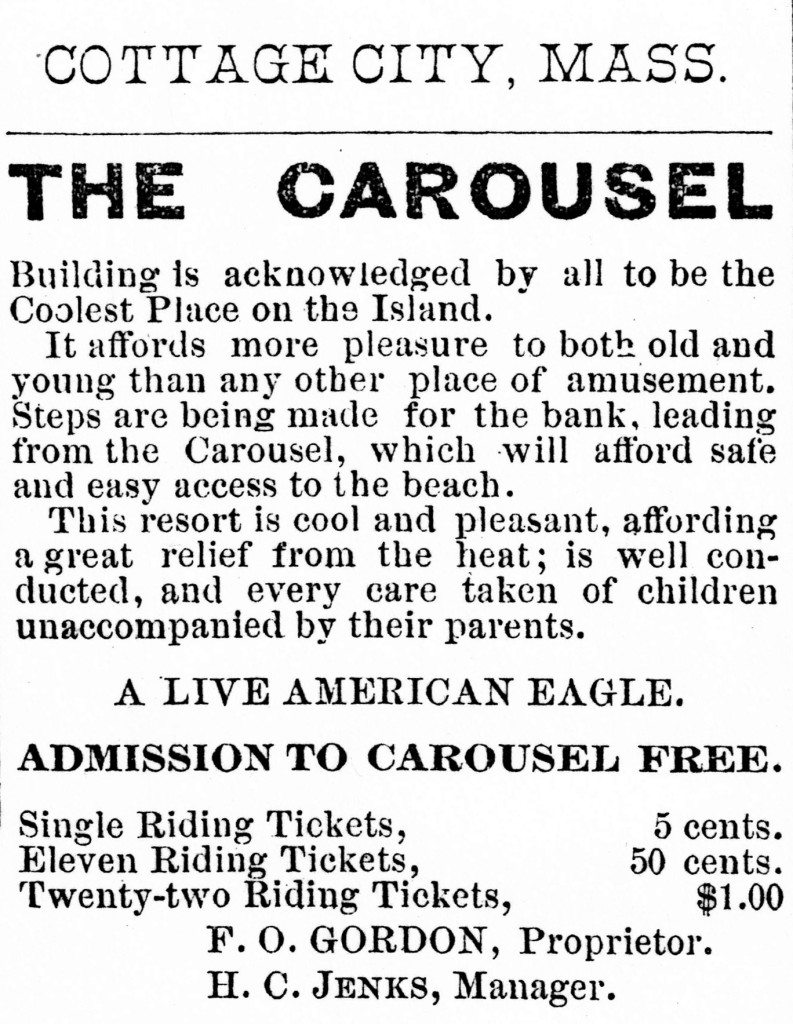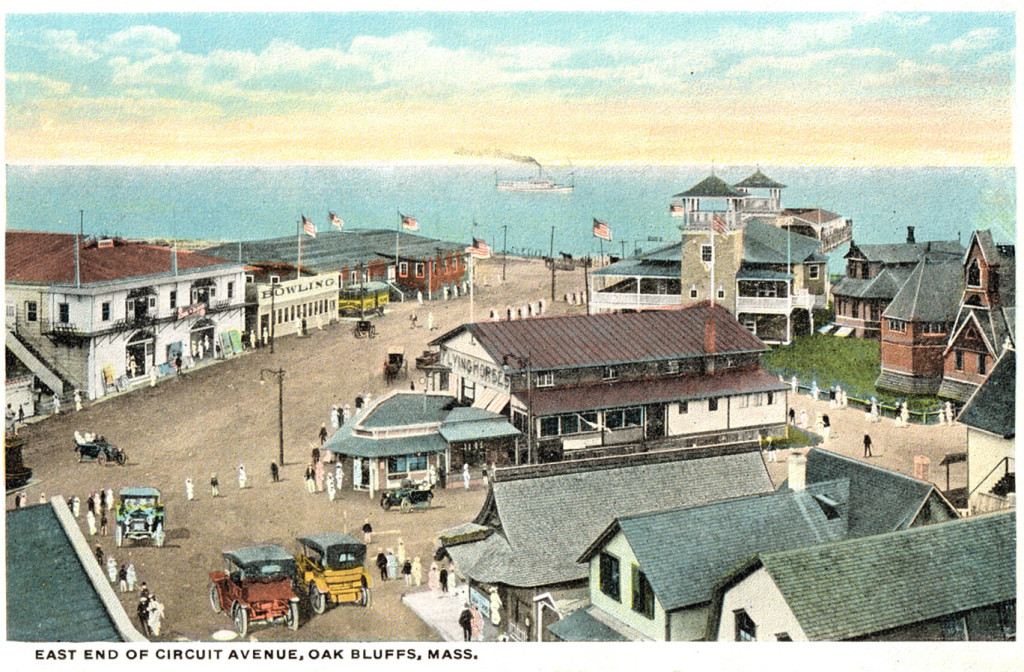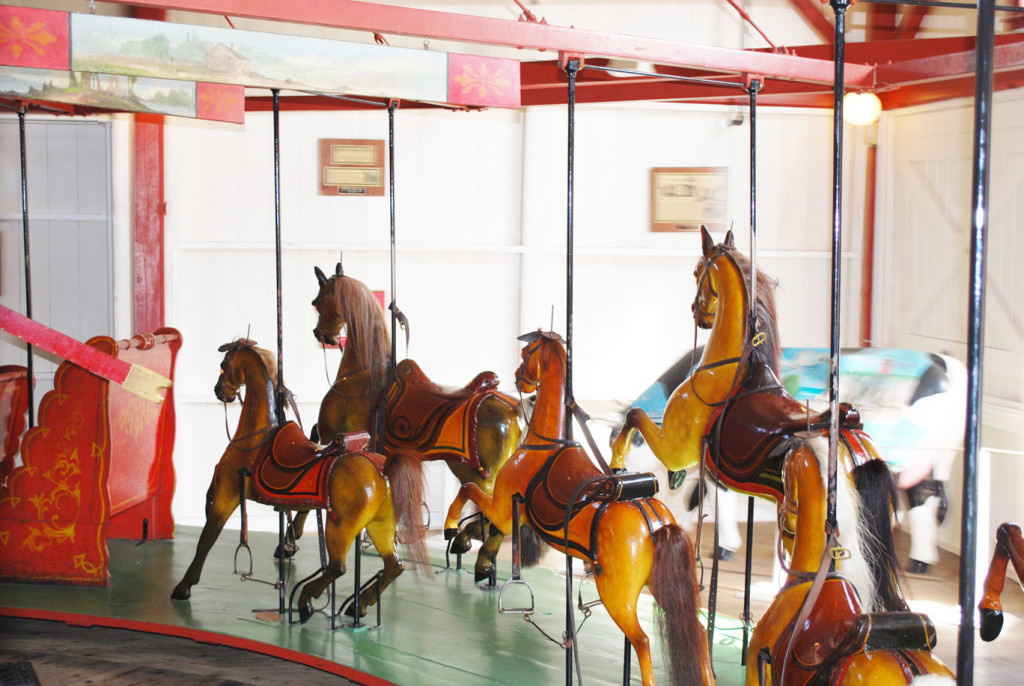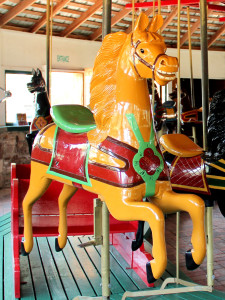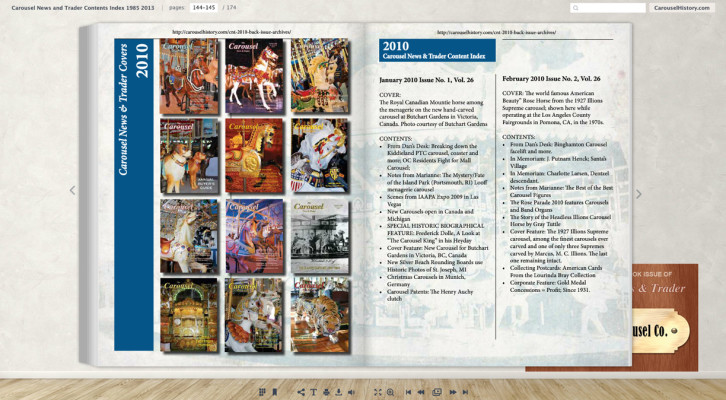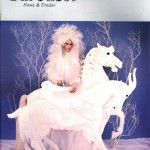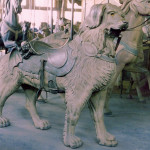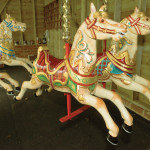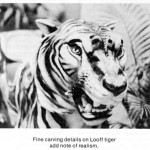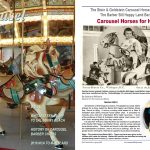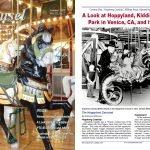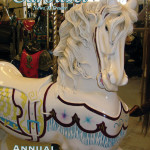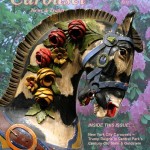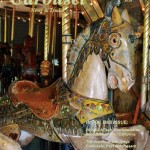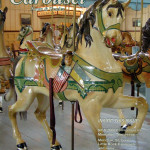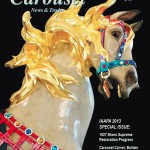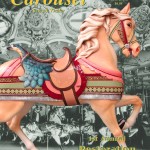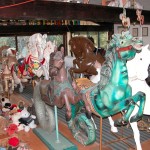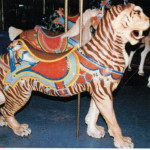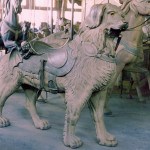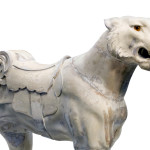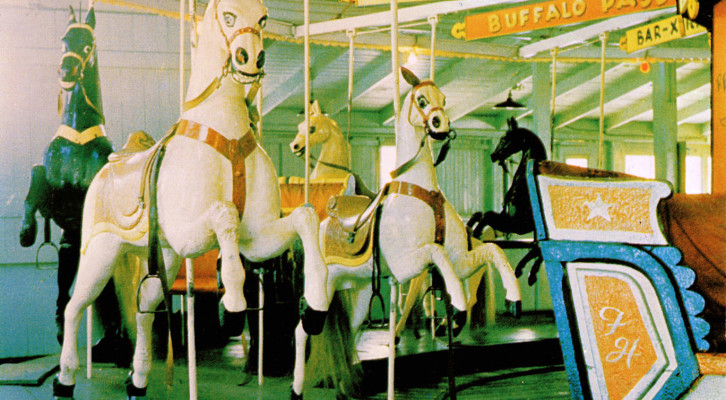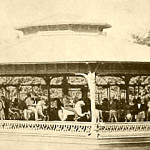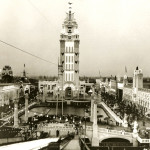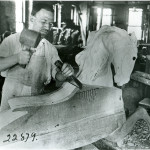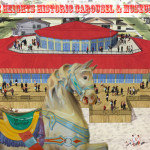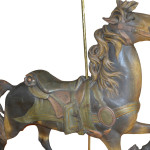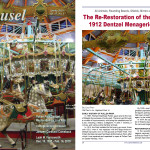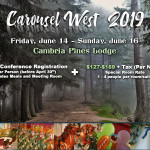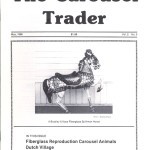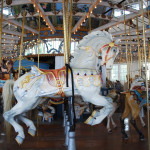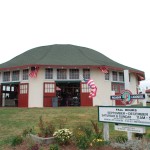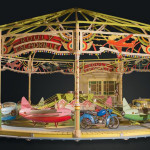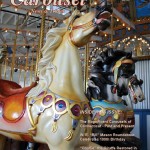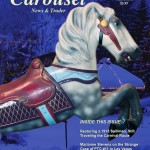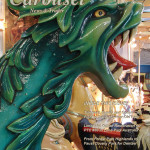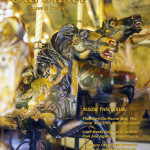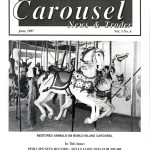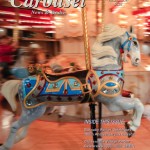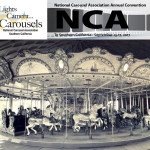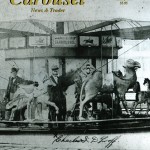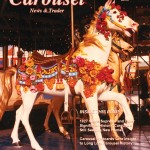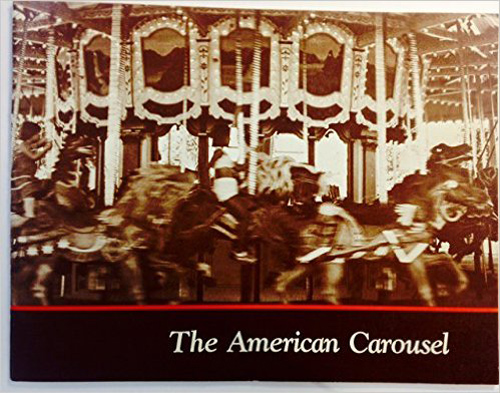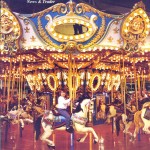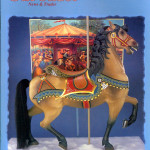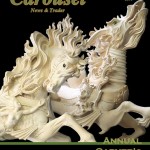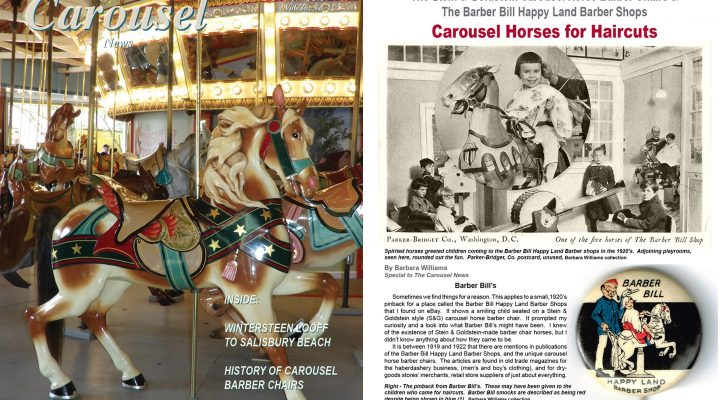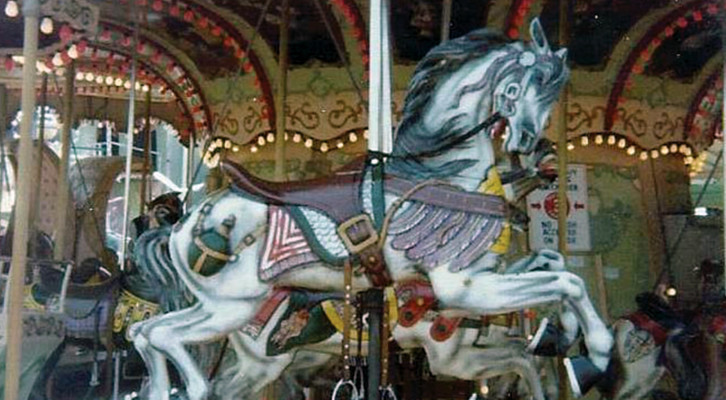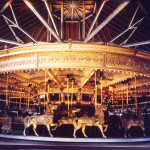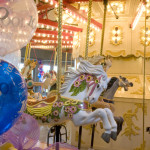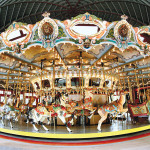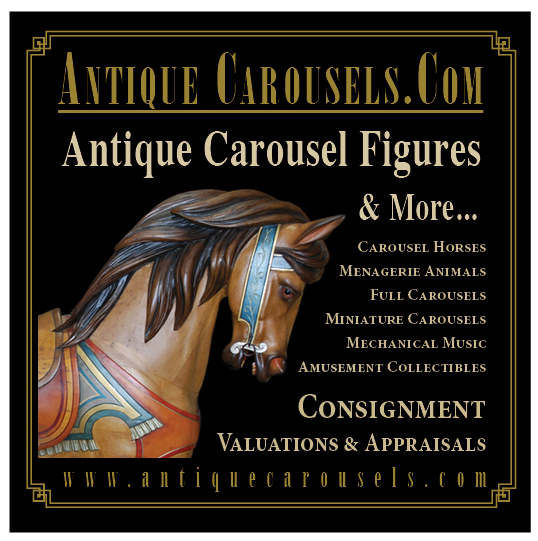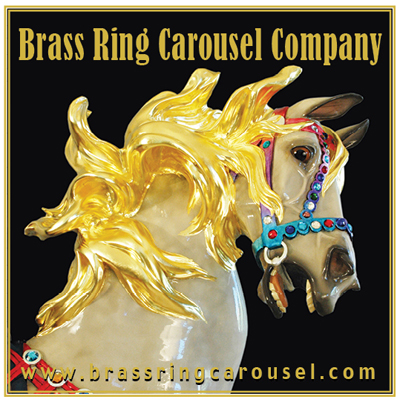Part 3 – Surviving Carousels, Discussion, References, Acknowledgements
PART 1 PART 2 PART 3
Carousel History Feature – American Carousel Pioneers – Andrew Christian and Charles Dare
Surviving Dare-Associated Carousels
Watch Hill, Westerly, Rhode Island
- Rides are limited to children on the Watch Hill carousel.
- The Watch Hill Carousel’s National Historic Landmark plaque.
- The carousel has a band organ case. Recorded music is played.
- The seaside location of the Watch Hill carousel. Roland Hopkins photos.
The Watch Hill carousel has hanging horses and it has no platform. As is discussed in the article, the horses are in a form that is consistent to those that were made by Andrew Christian. The carousel has always been considered a Dare carousel. If that’s the case, it would be an assembly with possibly a Dare-made frame combined with the Christian horses. The Watch Hill carousel horses had oil cloth and leather trappings. Dare’s hanging horses by circa 1884 were all wood. A possibility is that Watch Hill is a carousel that used Christian/Hoffmire et al. stock before Dare began making his own hanging horses.
Dare Swinging Carousel with Platform, Oak Bluffs, Martha’s Vineyard, Massachusetts
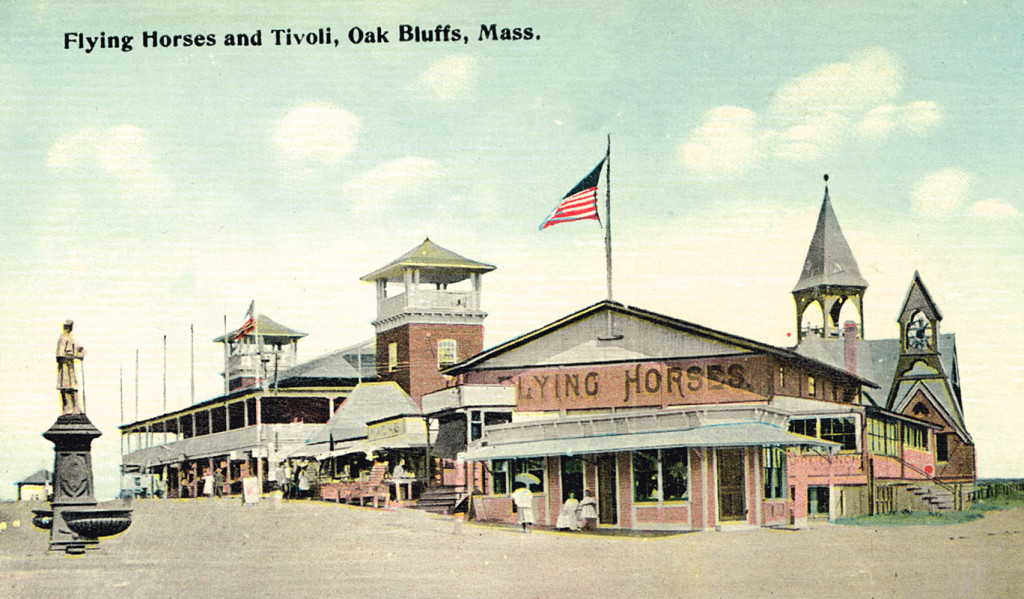
Early postcard of the carousel at Martha’s Vineyard, Oak Bluffs, Massachusetts. Barbara Williams collection
The following excerpts from “America’s Oldest Carousel” By Frederick Fried address the rediscovery of the original art on the Flying Horses carousel.
Entire article – “Flying Horses of Martha’s Vineyard Offer Surprise”, Antique Monthly, July 1974
“The rediscovery of the Old Oak Bluffs’ scenery panels, painted on canvas with scenes of the New England seaside, the Mary Powell steaming down the Hudson River, the romantic rural scenes, Trotters, jockey and horse, boy on velocipede and summer cottages in rural settings has attracted much recent attention. … Also discovered were spreader boards painted on both sides with views of schooners, seaside scenes and subject matter similar to the canvases on the outside rim and inside pole and machinery coverings.“
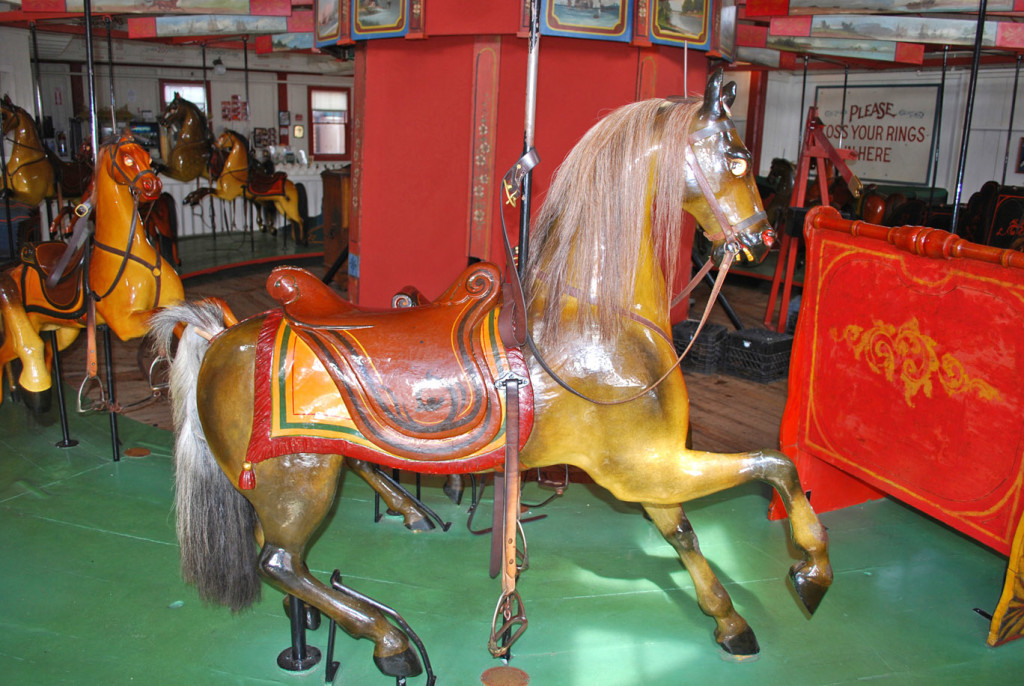
A standing horse on the Oak Bluffs carousel. There are also prancers, as can be seen in the background. Photo courtesy of Roland Hopkins
Mary Lucas, owner of the Flying Horses carousel –
“When we bought the ride there were cowboy paintings all over the place. I didn’t like them and I wondered what decorations had been there to start with and what had happened to them. The previous owner said they were in the dump a long time ago. I was brokenhearted to think they’d been destroyed, but when I called the man who’d painted the cowboys, he said he hadn’t taken the old pictures to the dump after all. He didn’t have any idea of where they were, though.” (40)
“A search of the premises, conducted by flashlight that night tuned up an amazing find – the original scenery panels and spreader boards! They were all there, stacked behind the new paintings. They were in remarkably good shape and have helped establish the carousel manufacture date. What a bonanza! …They had been there all along, preserved by accident.”
Update – Bob and Mary Lucas later sold the carousel and it was placed on the National Register of Historic Places on August 20, 1979
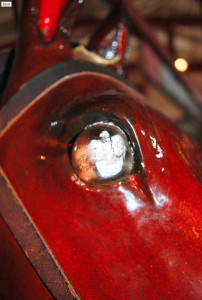
Dare’s horses had either sulfide eyes with plaster figures embedded in them or swirly marbles. Here the figure appears to be a bird with its wings spread. Lourinda Bray says she has also seen an owl, a sheep, a lion and a rooster in Dare’s eyes.
Discussion
As mentioned early in this article, while researching the history of Bill’s Andrew Christian Spring Rocking Horse, we came across an intriguing comment in the December 2008 issue of The Carousel News and Trader in an article by Gary Anderson. (1) He pointed out the similarity of the Watch Hill, Westerly, Rhode Island’s carousel horses to those found on Christian’s rocking horses and further claimed that “the Watch Hill Carousel was probably built in 1867, the only year that Christian and Dare worked together (no reference was provided), the year before Christian died”. We agree with Anderson’s finding of the similarity of the Christian Spring Rocking Horse and figures on the Watch Hill and other early carousels. However, we quickly determined that Christian died in a carriage accident in 1871, several years after the 1868 death claim. We also began to search for Anderson’s unreferenced source for the 1867 connection between Christian and Dare. We weren’t successful but did find an additional unreferenced citation in Marshall and Inez McClintock’s book that Christian and Dare worked together “from 1868”. (41)
Based on this early research we set out to determine if we could find actual period information that would address the following:
1. Was Andrew Christian involved in the production of early carousels such as Watch Hill that had Christian-like figures similar to those on the Watch Hill carousel? If so, which carousels had similar figures and can we connect them to Andrew Christian?
A thorough analysis of the forms of various 1860’s and 1870’s spring rocking horses and other types of children’s horse toys shows that only Andrew Christian originally used horses in which the angle of the foreleg projected above the line formed by the horse’s belly. This observation supports Anderson’s conclusion that Christian likely supplied the horses on the Watch Hill carousel. Similar style horses are seen on the carousel in opening image of this article, page 17 of an article by Patricia Mullins (39) and in early images of the Central Park and Prospect Park carousels. That said, we have found no information supporting or disproving that Christian or his successor firm Hoffmire et al. built the carousels or may have simply supplied the figures to the builder of the carousels. The payment to Hoffmire et al. in 1874 (11) to repair the Central Park horses suggests the possibility of a previous link of Christian to that carousel.
2. What is documented evidence that Andrew Christian worked with Charles W. F. Dare?
Although both Gary Anderson and the McClintocks’ claim that Christian and Dare worked together in 1867 and 1868, respectively, neither claim is documented. It is clear that the Christian business was important to Dare since he appears to have purchased the business from Christian’s successors and began occupying Christian’s manufacturing facilities by 1876. If Christian didn’t build the early carousels populated with his figures, someone else did. At this point, Dare could be included as one of the possibilities. We hope that this article may result in additional information coming forward that may clarify this.
3. What is known about the evolution of the Dare carousel business?
Charles Dare appears to have started in the toy business in the late 1850’s. The first advertisement that we found dated to 1863 and he began to appear in New City Directories by 1867. In the many newspaper articles that we found about his business prior to 1884, no mention is made about carousels. We have no explanation for this. However, soon after forming The C.W.F. Dare Company in 1884, Dare published an extensive “carousal” catalog. Furthermore, two newspaper articles were found from that year stating that he manufactures carousels for domestic and international purposes and that his export business exceeds those for domestic use. The breadth of offerings in the catalog and the extent of his business suggests that he had been manufacturing carousels for a significant period of time. Very little difference is seen in the carousel and figure offerings between the circa 1884 and circa 1890 catalogs so his offerings appear to have been well established by 1884. However, the 3 styles of carousels offered in the catalog: Swinging Carousel with no Platform, Carousel with a Swinging Platform and the Galloping Horse Carousel, in themselves, would seem to suggest an evolution of his carousels during the development of his business, going from rather primitive to more contemporary, but all three styles are offered throughout what we see of his carousel business. Unfortunately, we haven’t been able to find any evidence defining exactly when his carousel business began.
Dare Horses – Parker Frame, Fireman’s Park, Brenham, Texas
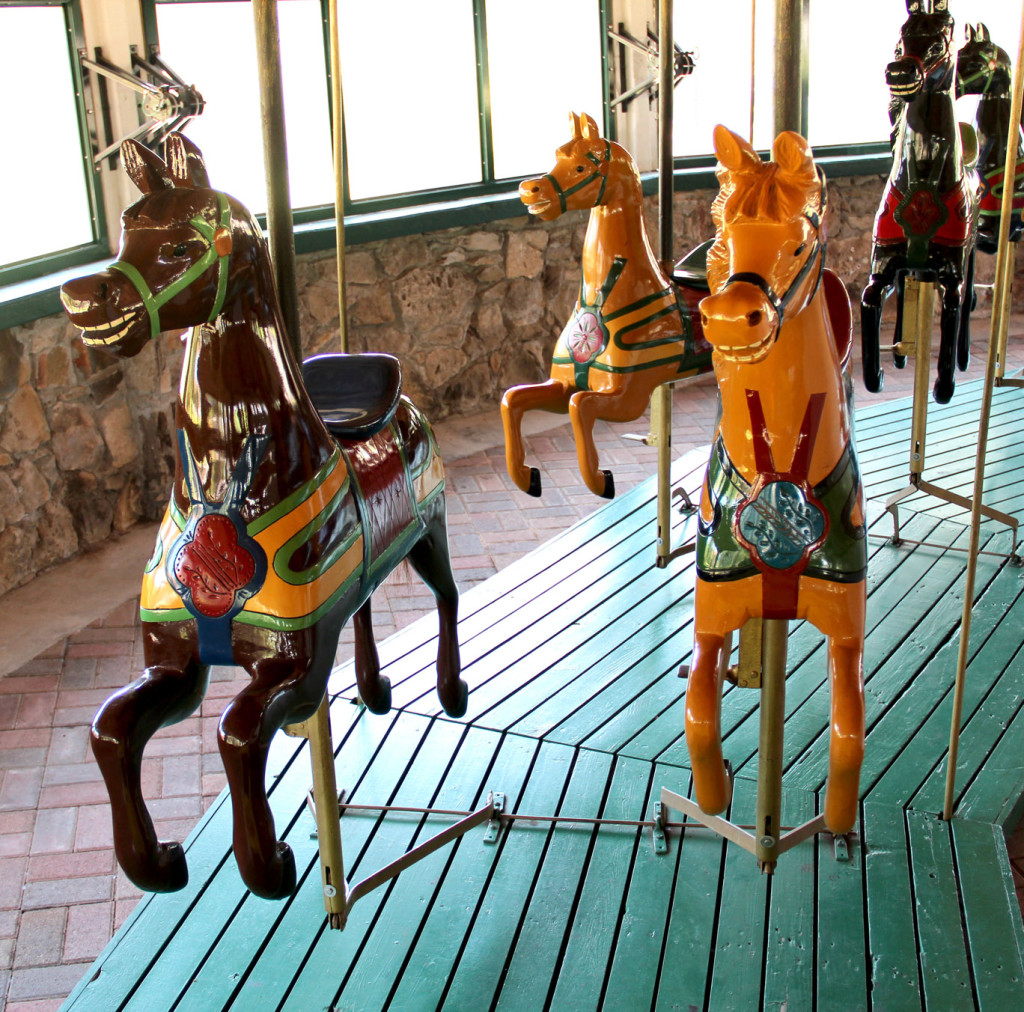
Fireman’s Park, Brenham, Texas – Typical Dare horses with friendly faces and martingales at the chest. Photos courtesy of Crystal Locke, City of Brenham, Texas.
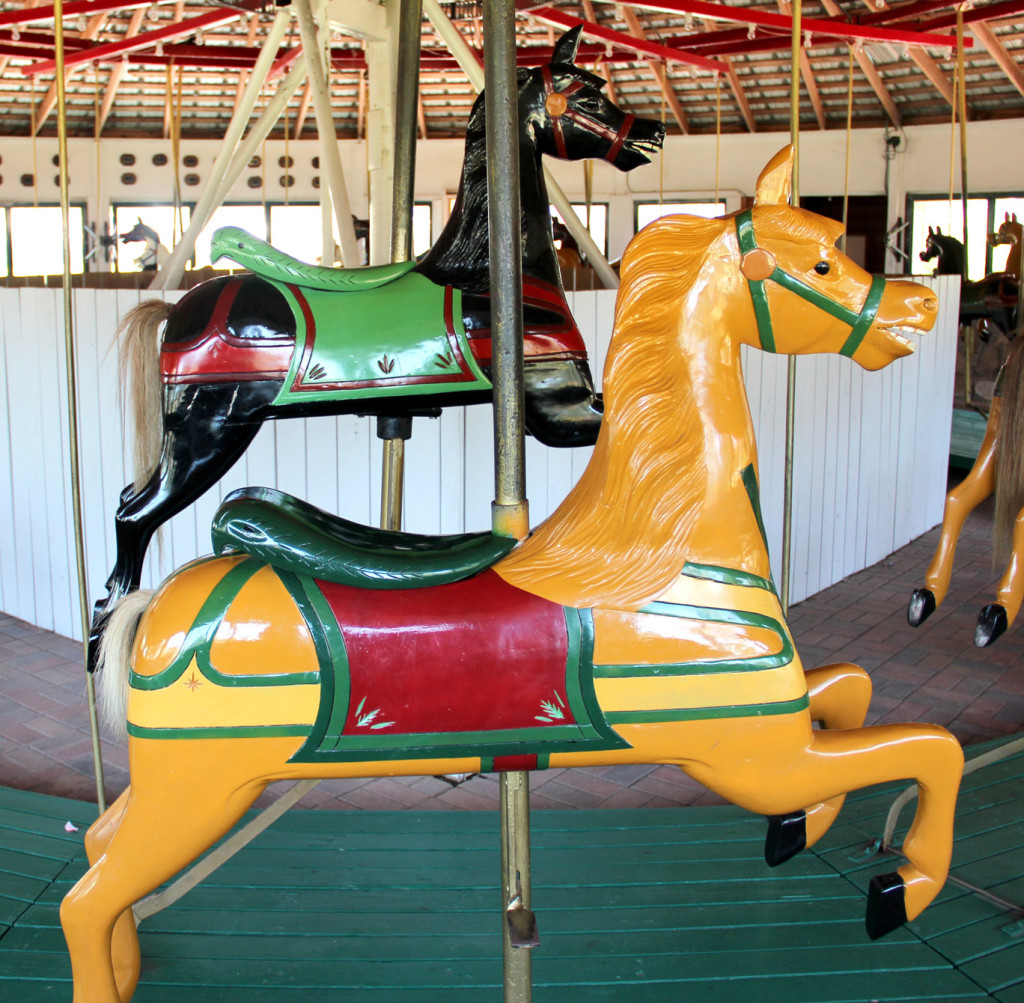
Despite the fact that a few of the horses on the Brenham, Texas carousel have Armitage-Herschell ID plaques on them, the horses are all of the same style which is consistent with Dare. The frame is a Parker with the grasshopper jumping mechanism. This machine is an assembly. It’s unknown as to how it came to have Dare horses.
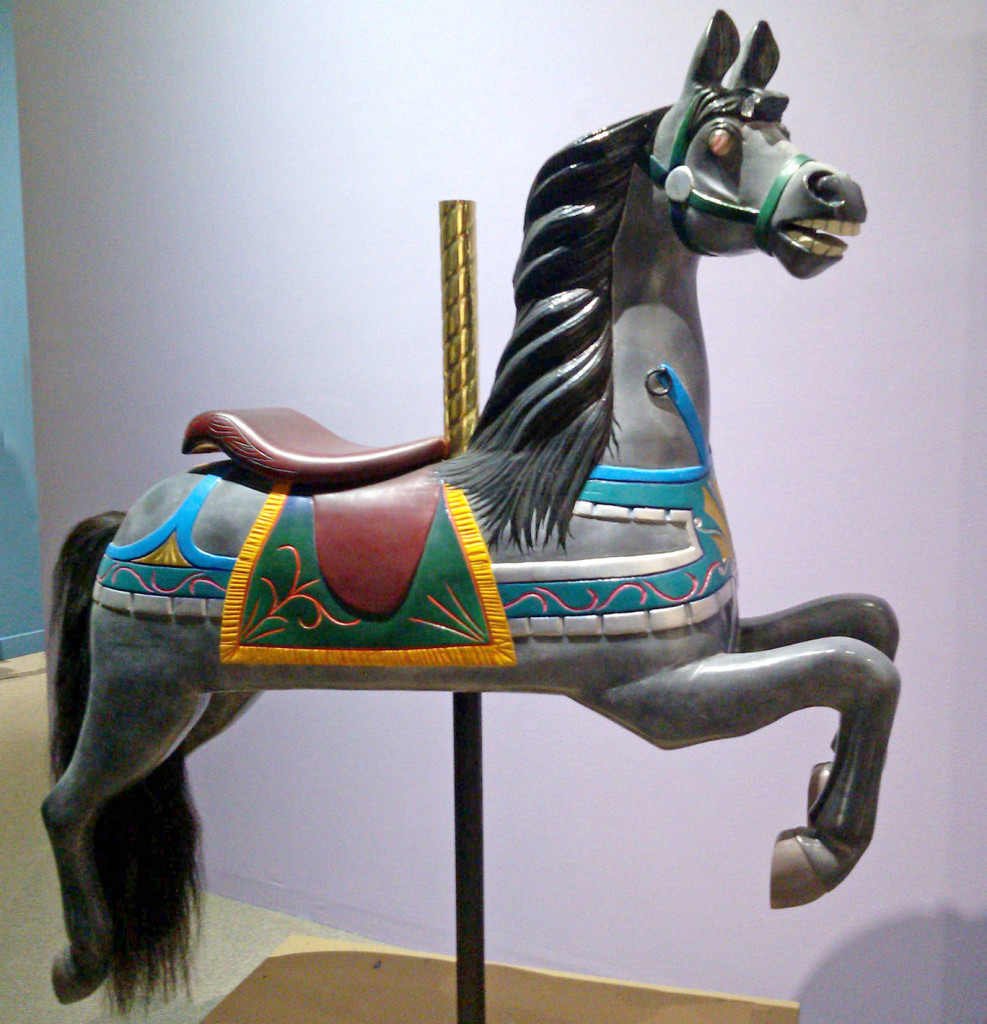
Restored Dare carousel horse from the Lourinda Bray, Running Horse Studio collection. The front has the signature (neck strap) martingale (below). The decorations at the front of this Dare are more elaborate than usual.
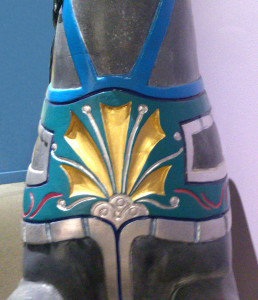 It’s a shame there are not more survivors of the early-day carousels. The makers were the pioneers, those innovative and brave enough to venture into unchartered waters with their simple machines and primitive animals. From humble beginnings of going around in circles, the earliest carousels set the stage for what was to follow – much larger and more elaborate, animated, illuminated carousels that glitter and dazzle. Without their forbearers, we wouldn’t have carousels that leave us speechless in the glow of their splendor.
It’s a shame there are not more survivors of the early-day carousels. The makers were the pioneers, those innovative and brave enough to venture into unchartered waters with their simple machines and primitive animals. From humble beginnings of going around in circles, the earliest carousels set the stage for what was to follow – much larger and more elaborate, animated, illuminated carousels that glitter and dazzle. Without their forbearers, we wouldn’t have carousels that leave us speechless in the glow of their splendor.
It’s an honor to be able pay homage to Charles Dare, one of the great carousel pioneers who, through thick and thin, kept on making carousels for the enjoyment of people around the world. As far as we know, there is only one surviving, complete Dare carousel. How fortunate we are to have such a treasure!
Along the journey of this research we diverged into many directions and discovered additional unexpected information, some of which is included in the present article and some which will be incorporated into future articles.
References
1. Brass Rings, Ice Cream and Sea Breezes at Watch Hill Carousel in RI – Primitive Dare Swing Machine May Date Back as Early as 1867. The Carousel News & Trader, December, 2008
2. THE ROCKING HORSE – A history of toy moving horses. Patricia Mullins. New Cavendish Books. 1992
3. New York State Tax Roll, April, 1863
4. Fire in Mangin-Street. Engine-House Destroyed. November 23, 1865, The New York Times
5. Fire Last Night. Destructive Conflagration in Mangin-Street – A Children’s Fancy Carriage and Hobby Horse Manufactory Totally Destroyed – Loss from $75,000 to $100,000, October 3, 1866, The New York Times
6. Brooklyn – Affairs. Fatal Result of an Accident, October 23, 1871, The New York Herald
7. A New York Merchant Killed, October 23, 1871, NY Tribune
8. House News, Brooklyn, October 23, 1871, The Sun
9. Thrown from Car and Killed, May 10, 1872, The Sun
10. Documents of the Board of Commissioners of the Department of Public Parks for the Year Ending April 30th, 1871. Evening Post Steam Presses, New York
11. Minutes of Proceedings of the Board of Commissioners of the Department of Public Parks for the year ending April 30, 1874. Evening Post Steam Presses, New York, 1874
12. Report of the Brooklyn Park Commissioners from January, 1874, to December 31, 1879
13. Obituary. Charles W. F. Dare, April 3, 1896, The Daily Standard Union, Brooklyn
14. Wiped Out, June 21, 1878, The Cincinnati Enquirer
15. The Fire Record. At No. 89 Mangin, December 1, 1876, New York Daily Tribune
16. A Pictorial History of the Carousel. Frederick Fried. Bonanza Books, N.Y. 1964
17. Charged With Burning His Factory, April 11, 1876, New York Daily Tribune
18. All Around the Globe, April 12, 1878, The New York Times
19. Burning Up Stacks of Toys, February, 12, 1885, The Sun
20. Local Business Troubles, June 28, 1878, The New York Times
21. Failures, October 23, 1883, The Inter Ocean, Chicago, Illinois
22. The First National Bank of Cortland vs C.W.F. Dare. Inquest. Verdict for plaintiff for $738.56. February 15, 1884, Cortland New York News
23. Advertisement and Good Children, April 28, 1863, Paterson New Jersey Daily Guardian
24. Findings of Fact. Supreme Court. Reg 43, Fol 30. Martin B Brown, Law Printer and Stationer, N.Y. 1892
25. The Most Wonderful Invention, October 25, 1878, New York Daily Graphic
26. July 14, 1884, Brooklyn Union
27. The Merry-Go-Round, July 13, 1884, The Sun
28. New York’s Great Industries, 1884
29. The Carousel Business, June 29, 1892, The Sun
30. The National Corporation Reporter Vol. 4 p 406, 1892
31. Minutes of Proceedings of the Board of Commissioners of the Department of Public Park for the Year Ending April 30th, 1893
32. Died, November 1, 1871, New York Sun
33. November 23, 1873, Buffalo Courier
34. Minutes of the Park Commission, The Brooklyn Daily Union, March 11, 1874
35. Prospect Park, The Carousel, June 7, 1875, The Brooklyn Daily Eagle
36. Drunken Rowdies…destroy the revolving hobby horses and swings with axes “, June 30, 1878, New York Times
37. NEW YORK by SUNLIGHT AND GASLIGHT. A WORK DESCRIPTIVE OF THE GREAT AMERICAN METROPOLIS. James D. McCabe, Douglass Brothers Publishers, Philadelphia, PA, 1882
38. Corkscrew Advances New Summer Vacation Theories, New York Morning Telegraph, June 15, 1902
39. Letters from Eagle Readers, March 4,1930
40. Carousel, Yankee Magazine, July 1976
41. Toys in America. A Profusely Illustrated History. Marshall and Inez McClintock. Public Affairs Press. Washington, D.C. 1961
42. Manhattan to Brooklyn Footsteps. Tracing C.W.F. Dare, Hobby Horses and Carousels in the Nineteenth Century, Merry-Go-Roundup, Fall, 2015
Acknowledgements
We thank the following individuals and institutions for providing images used in this article and for review and editing assistance. Lourinda Bray, Strong Toy Museum of Play, Rochester, New York, Roland Hopkins, Fred and Mary Fried Archive, American History Museum, Smithsonian, Carrousel Art magazine, Crystal Locke, Gray and Judy Tuttle, Dan Horenberger, Jordan Williams.

